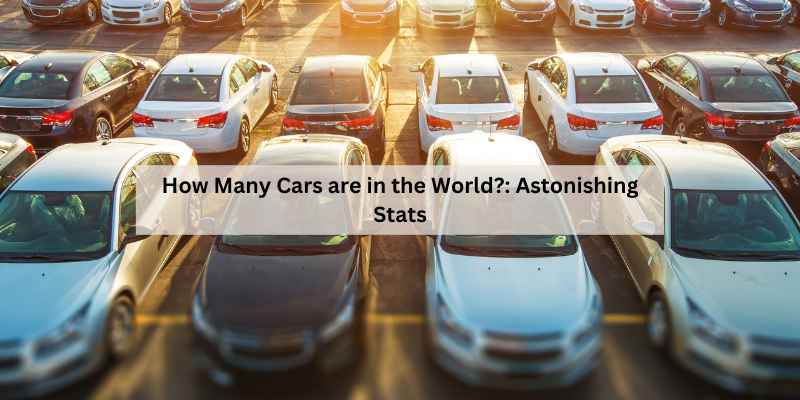How Many Cars are in the World?: Astonishing Stats
As of 2023, there are approximately 1.4 billion cars in the world. This number continues to rise as global demand increases.
The number of cars on the road reflects changing lifestyles and economic conditions. Cars have become essential for commuting, leisure, and business activities. Urbanization and population growth drive this demand, especially in developing countries. Environmental concerns and technological advancements also influence car ownership trends.
Electric vehicles are gaining popularity as consumers seek sustainable options. This shift impacts global markets and automotive industries. Understanding the total number of cars helps gauge transportation demands and environmental challenges. It also highlights the need for infrastructure and policy planning. The future of automotive transport will be shaped by innovation and sustainable practices.
Global Car Count: A Glimpse Into Numbers
As of 2023, there are approximately 1.4 billion cars globally. This number continues to rise each year. Understanding car growth is essential for various reasons.
The global car count has seen significant changes over the decades. In the 1960s, there were only about 200 million cars. By the 1980s, this number grew to around 500 million.
Today, emerging markets contribute to the rapid increase in car ownership. Countries like China and India are leading this growth. The demand for personal vehicles is high in urban areas.
| Year | Global Car Count |
|---|---|
| 1960s | 200 million |
| 1980s | 500 million |
| 2023 | 1.4 billion |
Factors Driving Car Ownership
Economic growth leads to higher car ownership rates. As people earn more money, they buy cars. This trend is seen in many countries.
Urbanization greatly impacts vehicle numbers. More people move to cities, increasing the demand for cars. Cities often have better roads and services for vehicles.
With more cars, traffic congestion can become a problem. Environmental concerns also rise with increased emissions. Balancing car ownership and city planning is crucial.
Automobile Production Insights
Understanding automobile production helps us grasp the scale of car manufacturing. The yearly manufacturing data shows significant trends in the industry.
| Year | Cars Produced (in millions) |
|---|---|
| 2020 | 77 |
| 2021 | 82 |
| 2022 | 86 |
Leading countries in car production play a vital role. China tops the list, producing over 25 million cars annually. Other notable countries include the USA and Germany, contributing significantly to global output.
Japan and South Korea also have a strong presence. These countries invest in advanced technology and innovation to stay competitive.
The Future Of Cars: Projections And Predictions
The future of cars is changing quickly. Electric vehicles (EVs) are becoming very popular. Many people want to reduce pollution. This trend is leading to more EVs on the road.
Countries are encouraging EV use. They offer tax breaks and rebates to buyers. Car manufacturers are also investing in EV technology. They aim to make cars cheaper and better.
New technologies will make cars smarter. Self-driving cars are being tested now. These cars could change how we think about transportation.
As EVs and smart cars grow, the total number of cars may change. Predictions suggest that by 2030, millions of new cars will be electric.
Tracking these trends helps understand the future of car numbers. The shift to electric is not just a trend; it’s a movement toward a cleaner world.
Environmental Considerations
The global car count is over 1.4 billion. Each car emits carbon dioxide and other harmful gases. These emissions contribute to climate change and air pollution. Reducing emissions is vital for a sustainable future.
Many countries promote electric vehicles to cut down emissions. These cars produce zero tailpipe emissions. Transitioning to electric cars can significantly lower the environmental impact.
| Statistic | Percentage |
|---|---|
| Recycled Vehicles | 75% |
| End-of-Life Vehicles | 20% |
| Electric Vehicle Market Share | 10% |
Recycling helps reduce waste and conserve resources. It is important to recycle old vehicles responsibly. Sustainable practices can lead to a cleaner planet.
Regional Variations In Car Ownership
Car ownership varies greatly across different regions. Urban areas often have a higher car density than rural ones. This is due to better infrastructure and public transport options in cities.
In rural areas, cars are essential for daily life. People rely on them for traveling long distances. Thus, car ownership is generally lower in these regions.
| Continent | Urban Car Density | Rural Car Density |
|---|---|---|
| North America | 800 cars per 1,000 people | 400 cars per 1,000 people |
| Europe | 600 cars per 1,000 people | 300 cars per 1,000 people |
| Asia | 200 cars per 1,000 people | 100 cars per 1,000 people |
| Africa | 100 cars per 1,000 people | 50 cars per 1,000 people |
Understanding these patterns helps in planning transportation policies. It also aids in improving infrastructure for better accessibility.
Public Policy And Its Influence
Government regulations play a major role in the number of cars on the road. These rules can limit or encourage car ownership. For example, strict emission standards may reduce car sales. On the other hand, tax breaks can boost car purchases.
Incentives and penalties also shape how many people own cars. Subsidies for electric vehicles make them more appealing. Higher taxes on fuel can discourage driving. Such measures affect people’s choices about car ownership.
| Type | Impact |
|---|---|
| Emission Standards | Reduces car sales |
| Tax Breaks | Encourages purchases |
| Subsidies for EVs | Increases appeal |
| Higher Fuel Taxes | Discourages driving |
Socio-economic Impact Of Car Proliferation
The growth of cars affects our daily lives. Many people rely on cars for mobility. This access opens doors to better job opportunities and services. Cities become more connected, making life easier for everyone.
On the downside, traffic congestion is a major issue. More cars lead to longer travel times. This can cause stress and reduce productivity. As roads fill up, air quality may also decline. Finding a balance is essential for a healthy community.
Frequently Asked Questions
How Many Cars Exist Globally?
As of 2023, there are approximately 1. 5 billion cars worldwide. This number includes both passenger vehicles and commercial vehicles. The figure continues to rise due to increasing urbanization and economic growth in developing countries. Understanding this statistic is vital for analyzing global transportation trends.
What Country Has The Most Cars?
The United States has the highest number of cars, exceeding 270 million registered vehicles. This figure represents a significant portion of the global total. Factors contributing to this high number include a strong economy and a culture centered around car ownership.
How Fast Is The Global Car Population Growing?
The global car population is growing at a rate of about 3% annually. This growth is driven by rising incomes and urbanization, particularly in emerging markets. As more people gain access to vehicles, the demand for cars will likely continue to increase.
What Are The Environmental Impacts Of Cars?
Cars contribute significantly to air pollution and greenhouse gas emissions. They are responsible for a large portion of urban smog and climate change. To mitigate these effects, many countries are promoting electric vehicles and sustainable transportation options.
Conclusion
The number of cars worldwide continues to grow, reflecting our increasing mobility needs. As urban areas expand, so does car ownership. This trend poses challenges, including traffic congestion and environmental concerns. Understanding car statistics helps us navigate these issues and make informed choices for a sustainable future.
Embrace the journey ahead.






